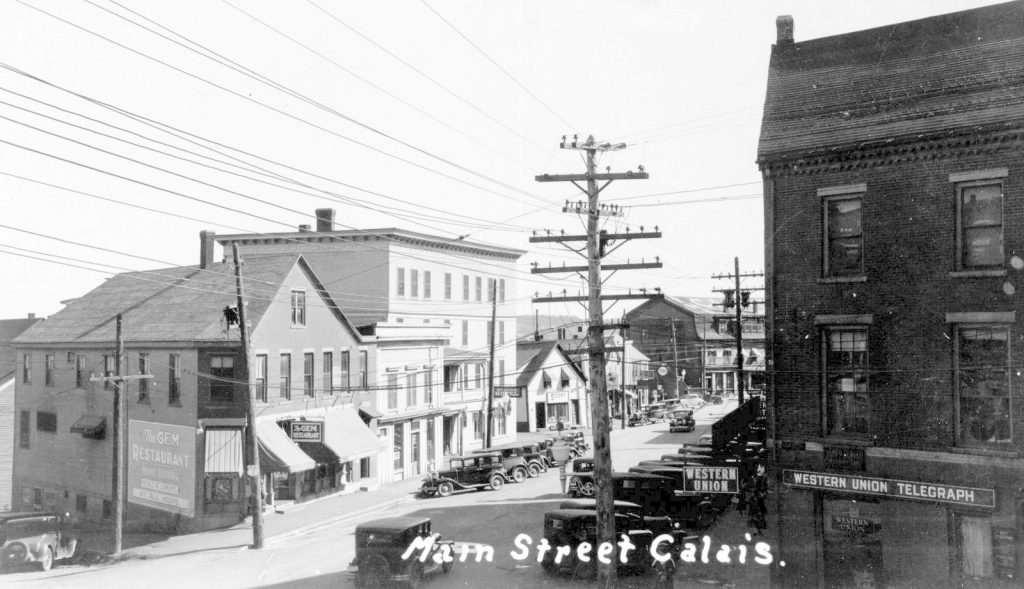
The Calais Western Union Telegraph office is shown above at the lower right at the corner of Main and North Streets in the 1920s. By the 20s the telegraph was becoming an outdated technology, but it had had a long and useless life locally beginning in 1847 when the first telegraph office was established in Calais. In the early days Calais was an important station – all the traffic from New Brunswick (which meant the news from Europe) passed through Calais, and the station had a large staff.
In the days before ship to shore radio, ships from Europe passing the northeast coast of Nova Scotia would throw canisters containing the European newspapers overboard to be picked up by boats in the employ of the wire services. The papers were taken to shore the news transmitted by telegraph through Nova Scotia and New Brunswick to Calais where the messages were repeated to the rest of the United States. Calais residents were the first in the country to know of momentous international events.
Stories about Calais and the St Croix Valley also went over the wire and found their way into hundreds of local and national papers. Most described odd, bizarre or humorous goings on by Downeasters and we thought we’d lighten the mood of end this gloomy year by sharing a few.
(Note: all of the articles and snippets below appeared in dozens if not hundreds of newspapers in the U.S. and Canada.)
From the Iowa County Democrat July 1868:
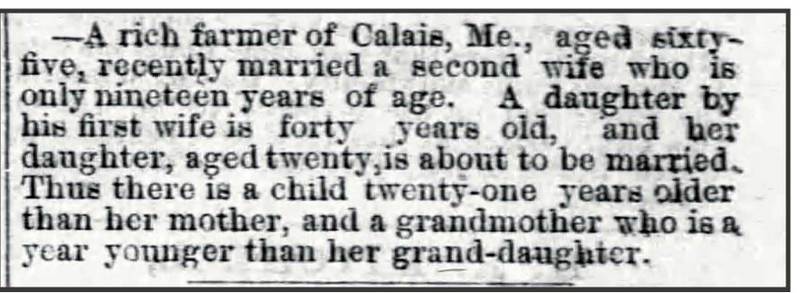
We cannot tell you who this “rich farmer” was because, frankly, no one in Calais history ever got rich farming.

While the writer could not have been deceived in 1868 by the postcard above, which dates from the early 1900s, he would have questioned his sources had he ever been to Calais and traveled the 14 miles of Calais from the Baring line to the Robbinston line. Had he done so he would have observed that Calais has almost no decent farmland, only a thin strip of very poor soil between Maguerrewock Ridge and the river. There was no rich farmer of any age in Calais let alone 65, a ripe old age for 1868, the only people in Calais and St. Stephen who became wealthy were the lumber barons. Had it not been for the farms in Charlotte, Alexander and Meddybemps and the ridges on the Canadian side we would have been forced to survive on fish from Eastport.
From the Buffalo Commercial 1866:
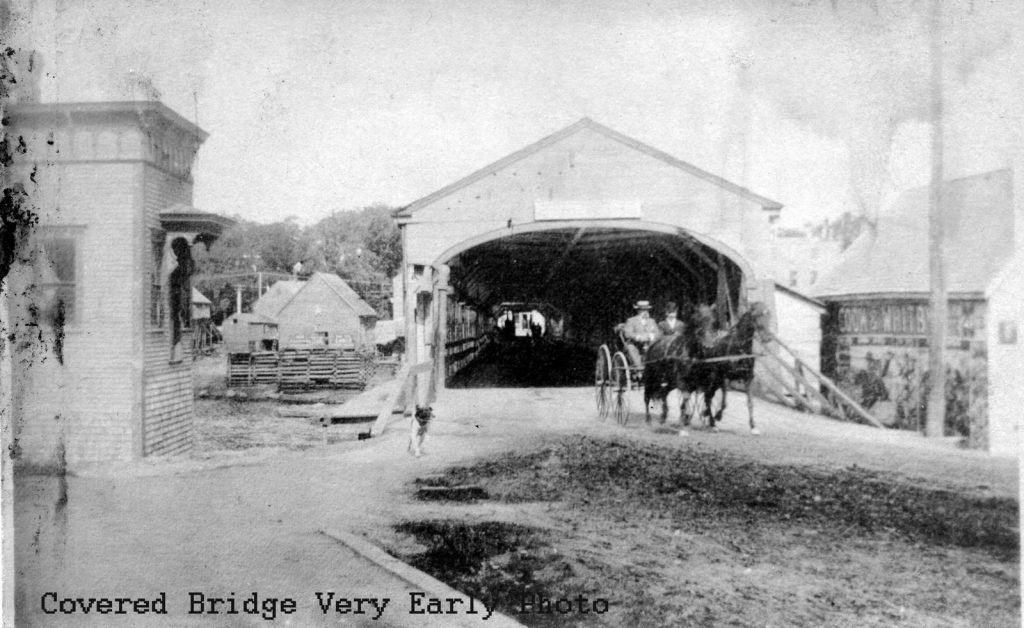
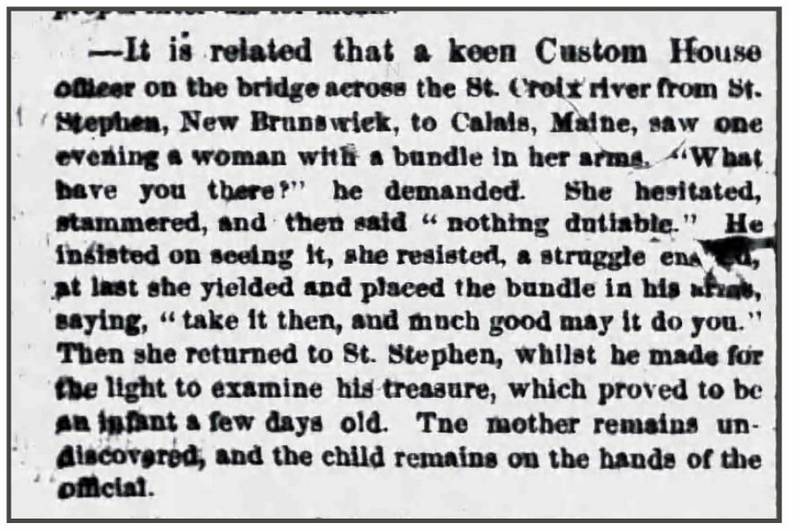
It is related that a keen Customs Officer on the bridge across the St. Croix river from St. Stephen, New Brunswick, to Calais, Maine, saw one evening a woman with a bundle in her arms. ‘”What have you there” he demanded. She hesitated, stammered, and then said ” nothing dutiable.” He insisted on seeing it, she resisted, a struggle ensued at last she yielded and placed the bundle in his arms, saying, ” take It then, and much good may It do you.” Then she returned to St. Stephen, whilst he made for the light to examine his treasure, which proved to be an infant a few days old. The mother remains undiscovered and the child remains on the hands of the official.
We can only hope the inspector who had inadvertently adopted this child was one Mr. Welch, a one eyed toll keeper on the old covered bridge shown above, a man known as the most hated man in Calais for many years.
Hunting yarns from this area were very common in those early dispatches from Downeast. We include a couple below. We think you will agree Sam Spaulding has a lot to answer for.
Detroit Free Press 1876:
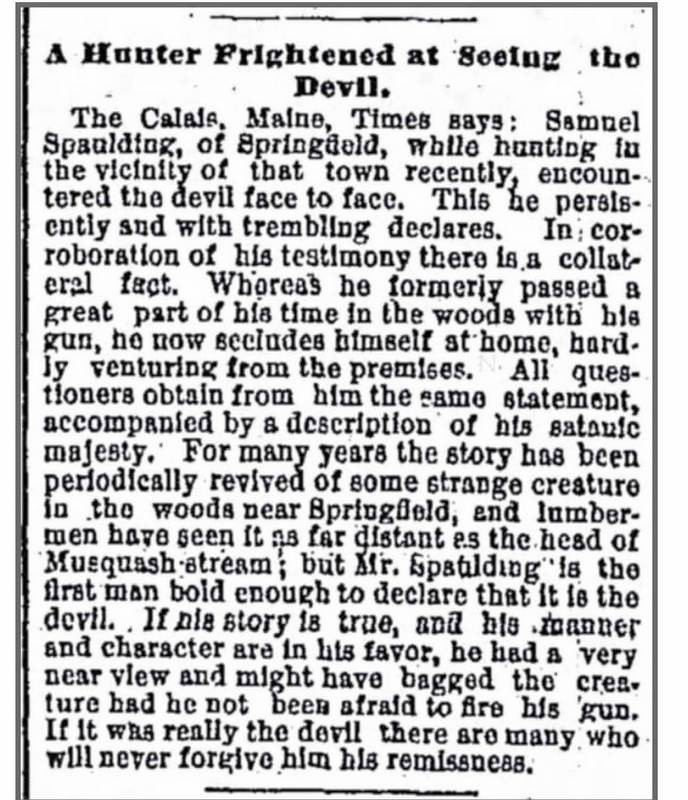
A Hunter Frightened at Seeing the Devil. The Calais Maine Times Says : Samuel Spaulding, of Springfield, while hunting in the vicinity of that town recently, encountered the devil face to face. This he persistently and with trembling declares. In corroboration of his testimony there is a collateral fact. Whereas he formerly passed a great part of his time in the woods with his gun, he now secludes himself at home, hardly venturing from the premises. All questioners obtain from him the same statement, accompanied by a description of his satanic majesty. For many years the story has been periodically revived of some strange creature in the woods near Springfield and lumbermen have seen it as far distant as the head of Musquash Stream but Mr. Spaulding is the first man bold enough to declare that it is the devil. If his story is true, and his manner and character are in his favor, he had a very near view and might have bagged the creature had he not been afraid to fire his gun. If It was really the devil there are many who will never forgive him his remissness.
Mower County Minnesota Transcript 1880:
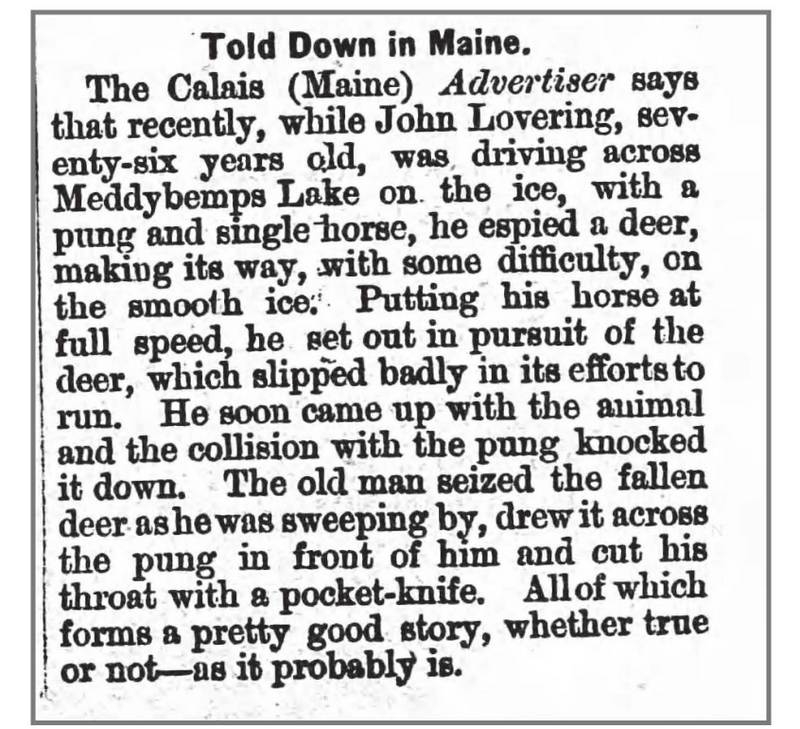
The foibles and imperfections of religious leaders were often the brunt of humorous anecdotes and yarns. There was also the Calais minister who threw himself off the pier in St. Stephen and was presumed drown only to be found alive hiding from a young lady who tracked him down to discuss a then very small matter of mutual interest.
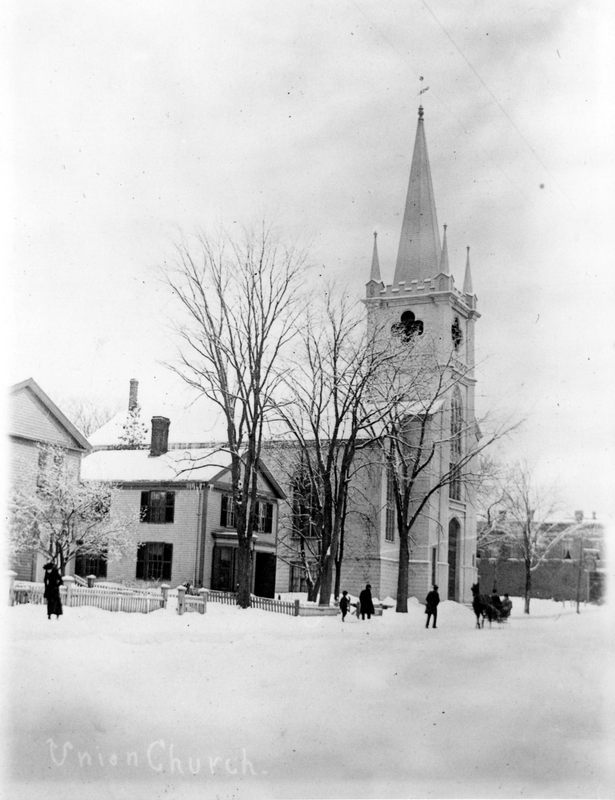
More edifying was the Nashville Union article of 1874 which reported that the Universalists of Calais who worshiped with the Unitarians in the lovely church at the corner of Main and the Avenue, now sadly the parking lot for the food pantry, had adopted what can only be considered an extremely enlightened position on the capabilities women for 1874 or, it must be said, for any age:
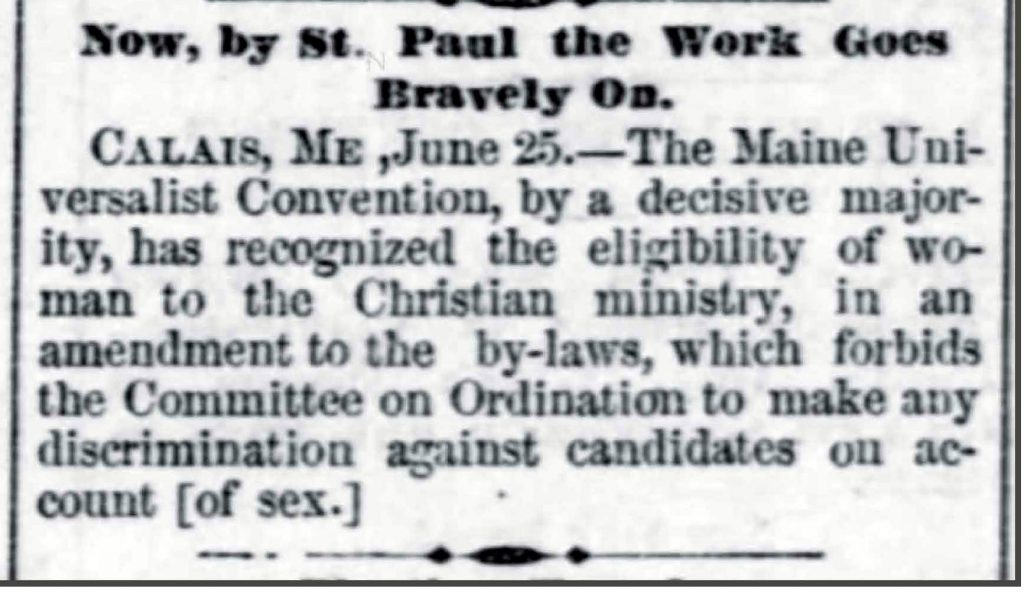
Religion in Calais was subject to serious criticism however in 1869 when the Hartford Courant published the article below:
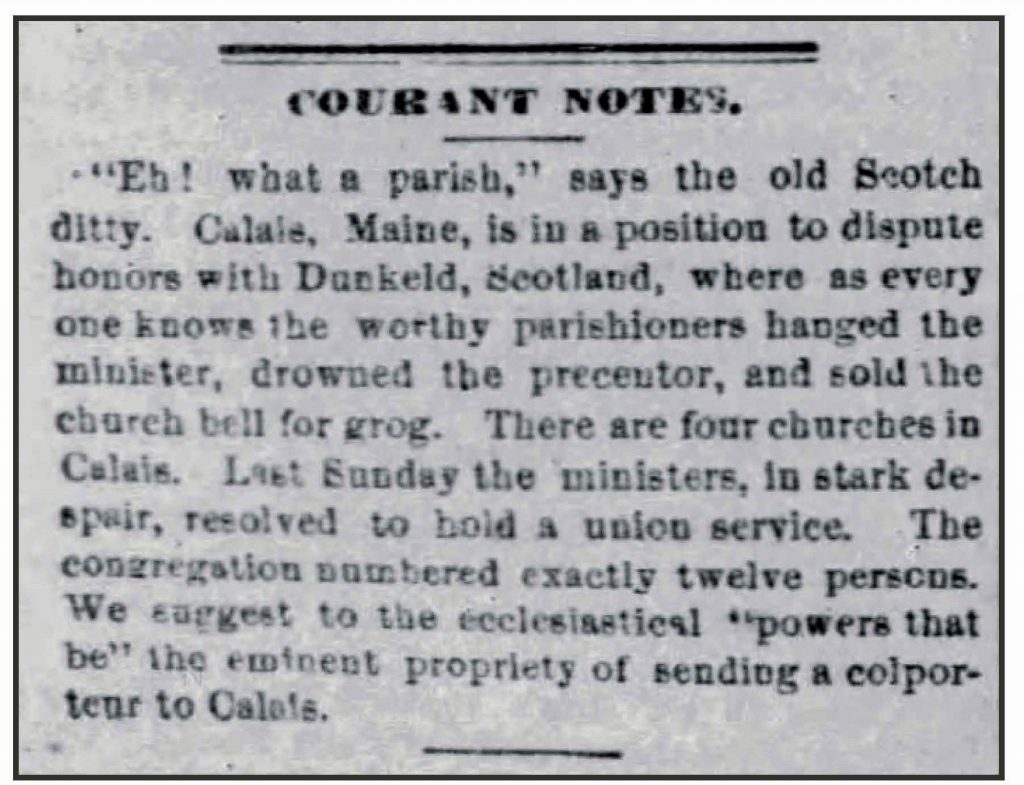
“Eh! what a parish,” says the old Scotch ditty. Calais. Maine, is in a position to dispute honors with Duckeld, Scotland, where as every one knows the worthy parishioners hanged the minister, drowned the precentor, and sold the church bell for grog. There are four churches in Calais. Last Sunday the ministers, in stark despair, resolved to hold a union service. The congregation numbered exactly twelve persons. We suggest to the ecclesiastical “powers that be” the eminent propriety of sending a colporteur to Calais.
We do question the veracity of this article as the religious community in Calais was very strong and vital during that period. There were more than four churches in Calais and, if fact, there were also four or five in Milltown. In the early 1870s the Congregationalists built the largest church in Calais history.
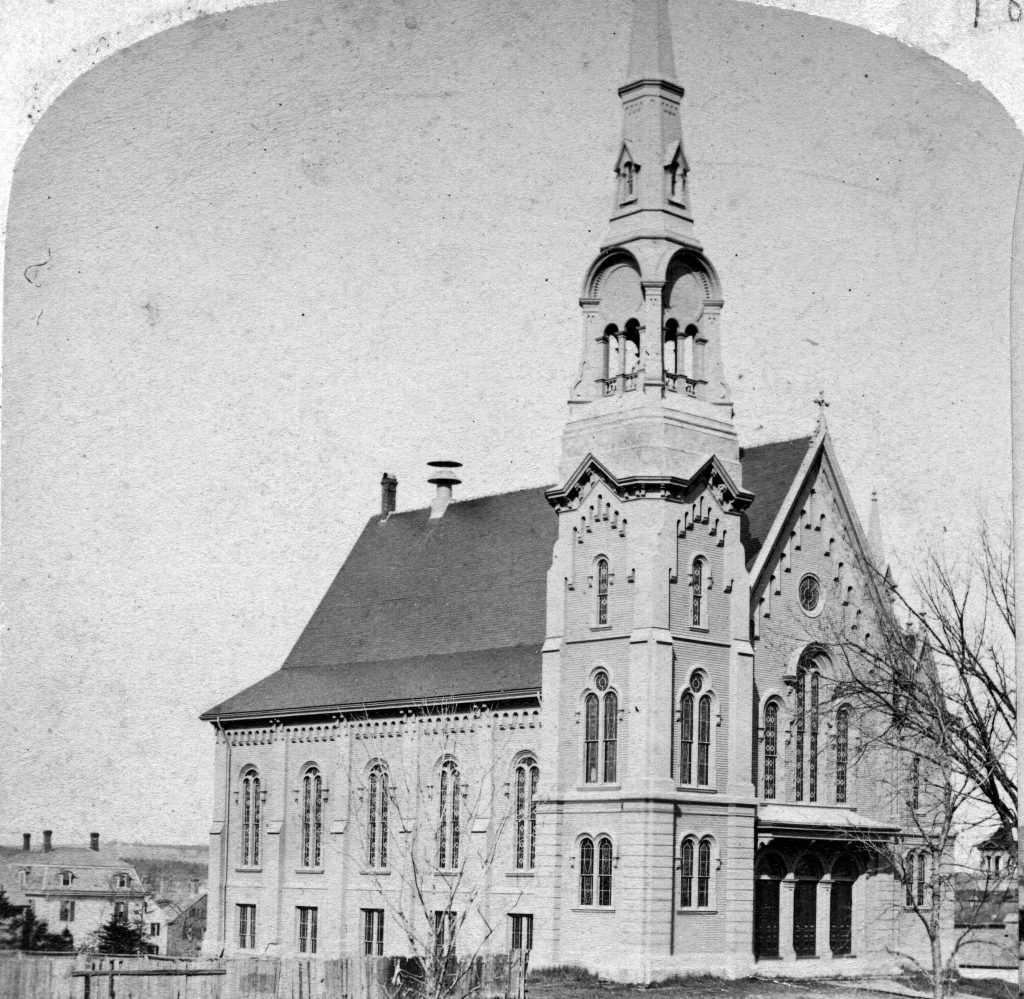
We think it unlikely this church would have built for a congregation of twelve unless, of course, the colporteur had been remarkable successful in his mission which, we discovered in dictionary, is to distribute bibles and religious literature to the faithful.
Our last religious story comes from the Pulaski Tennessee Citizen in 1870:
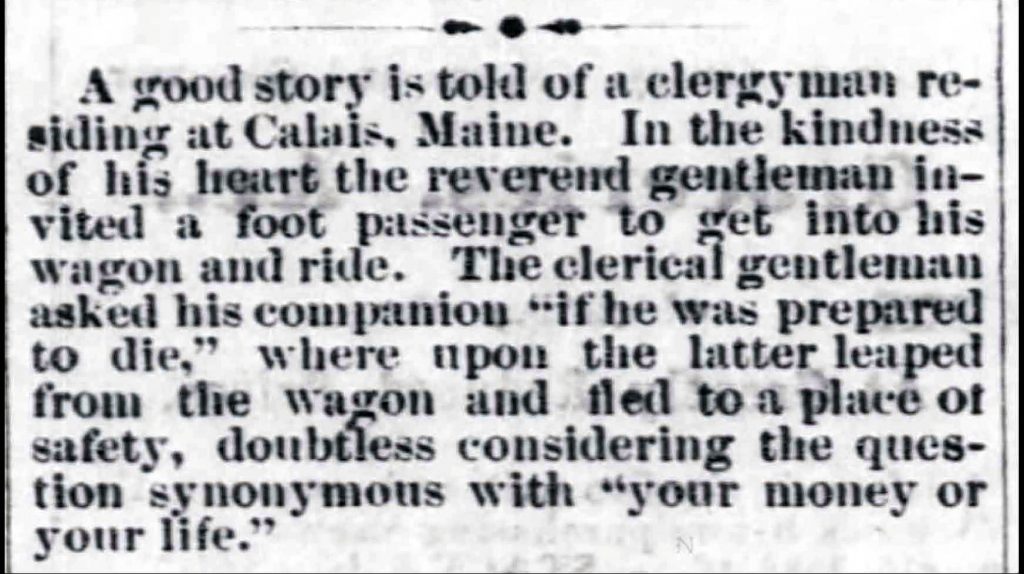
The Border Sentinel in Kansas mused in 1871 that Calais was a great place for a young man to find a wealthy heiress.

Certainly Calais had its share of attractive women, or at least a postcard from the early 1900s made the claim:

…and in 1871 it was undoubtedly true. The lumber baron Eatons, Todds amd Murchie all had a surplus of female offspring and to be perfectly frank many of the male heirs were spoiled, prodigal and unlikely to amount to much. The women, on the other hand, were much more highly regarded. There is little evidence the dissemination of the above article around the country led to an influx of eligible males and had they come they would have been disappointed. The lumber baron patriarchs may have been ready to vacate the field but many of the matriarchs of these families lived to a ripe old age. Many of the heiresses had a long wait.
Louisville Courier 1866:

A child at Calais, Maine, being troublesome from teething, was given a draft of infused poppies, which put It to sleep. This was on Tuesday night week, and at last accounts the child was still sleeping in spite of all efforts’ to arouse it. The physician entertains hopes that it may recover.
We don’t know whether the child recovered but we think it unlikely especially if given much of the contents of the bottle above which was sold over the counter in many Calais stores. At 46% alcohol with 3 grains of opium per ounce the contents were lethal in the hands of many doctors of the era. Few had attended any reputable medical school and the physician’s “hopes that the child may recover” were founded on hope alone, not medical science. This was left to the folks in Grand Lake Stream who believed, according to Grand Lake Stream folklore, that “Beads made from the feelers of a lobster worn around the neck will aid teething.”
From the Carson City Nevada Daily Appeal 1879:
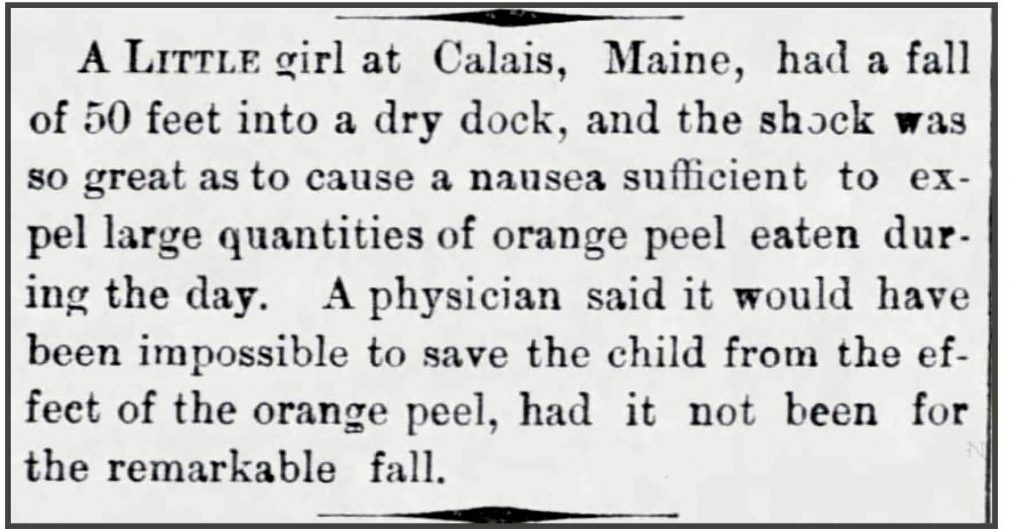
The folks in Grand Lake Stream may have also wrongly
believed that orange peels were poisonous and we’re reasonably sure
they had a cure. The Grand Lake Stream folklore collection has lots of
sounds advice:
1. Don’t ever cut the fingernails until the baby is a year old or he will grow up to be a thief.
2. Don’t let the baby play with a comb or he will stutter when he begins to talk.
The animal rights people might have been in touch with John Robinson of Calais after reading this story in the Kansas Onago County Democrat in 1881:
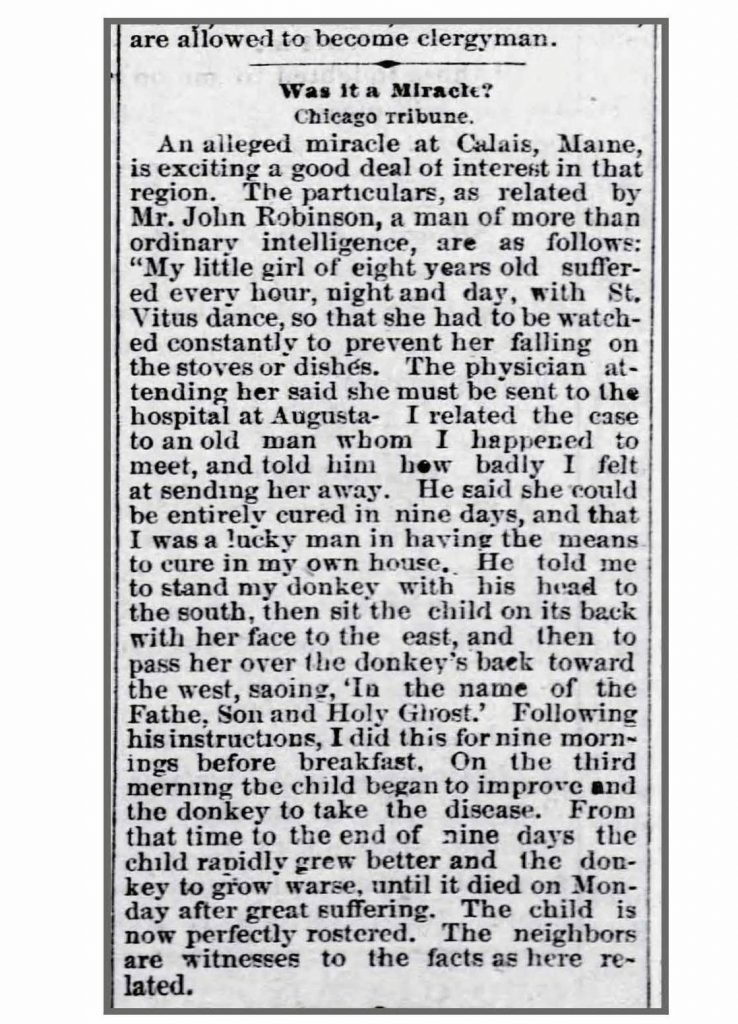
Was It a Miracle? Chicago Tribune. An alleged miracle at Calais, Maine, is exciting a good deal of interest in that region. The particulars, as related by Mr. John Robinson, a man of more than ordinary intelligence, are as follows: “My little girl of eight years old suffered every hour, night and day with St. Vitus dance, so that she had to be watched constantly to prevent her falling on the stoves or dishes. The physician attending her said she must be sent to the hospital at Augusta- I related the case to an old man whom I happened to meet, and told him how badly I felt at sending her away. He said she could be entirely cured in nine days, and that I was a lucky man in having the means to cure in my own house. He told me to stand my donkey with his head to the south, then sit the child on its back with her face to the east, and then to pass her over the donkey’s back toward the west, saying, ‘In the name of the Father, Son and Holy Ghost.’ Following his instructions, I did this for nine mornings before breakfast. On the third morning the child began to improve and the donkey to take the disease. From that time to the end of nine days the child rapidly grew better and the donkey to grow worse, until it died on Monday after great suffering. The child is now perfectly rostered. The neighbors are witnesses to the facts as here related.
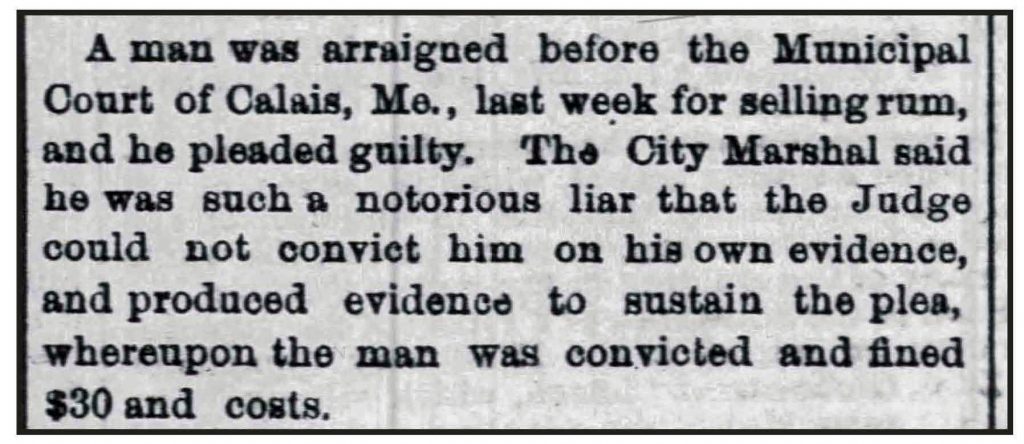
We’ll close with this gem from the Charleston South Carolina Courier of 1872. When a fellow can’t plead guilty to bootlegging without being called a liar by the cops who have charged him with that very offense, he’s reached a point where he probably needs a drink.
